#kushite deity
Explore tagged Tumblr posts
Photo
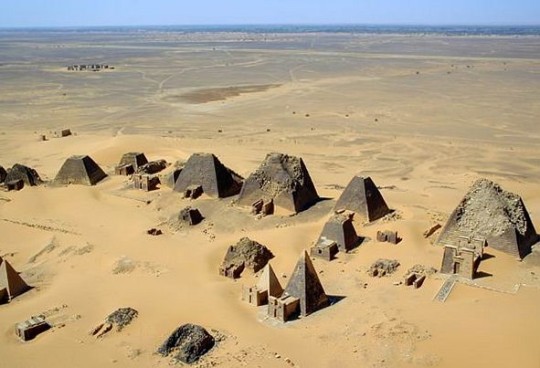
Meroë
Meroe was a wealthy metropolis of the ancient kingdom of Kush in what is today the Republic of Sudan. It was the later capital of the Kingdom of Kush (c. 1069 BCE to c. 350 CE) after the earlier capital of Napata was sacked c. 590 BCE. Prior to that date, Meroe had been an important administrative centre.
The city was located at the crossroads of major trade routes and flourished from c. 750 BCE to 350 CE. Meroe is listed by UNESCO as a World Heritage Site. As no one yet has been able to decipher the Meroitic script, very little can be said for certain on how Meroe grew to become the wondrous city written about by Herodotus circa 430 BCE, but it is known that the city was so famous for its wealth in ancient times that Cambyses II of the Persian Achaemenid Empire mounted an expedition to capture it. The expedition faltered long before reaching the city owing to the difficult and inhospitable terrain of the desert (and, according to some claims, may never have been mounted at all). Still, the persistence of the story of Cambyses' expedition suggests the great fame of Meroe as a wealthy metropolis.
The city was also known as the Island of Meroe as the waters flowing around it made it appear so. It is referenced in the biblical Book of Genesis (10:6) as Aethiopia, a name applied to the region south of Egypt in antiquity meaning "place of the burnt-faces". Although there is evidence of overgrazing and overuse of the land, which caused considerable problems, Meroe thrived until it was sacked by an Aksumite king c. 330 CE and declined steadily afterwards.
Egyptian Influence & King Ergamenes
While there was a settlement at Meroe as early as 890 BCE (the oldest tomb discovered there, that of 'Lord A', dates from that year), the city flourished at its height between c. 750 BCE and 350 CE. The Kingdom of Kush, founded with its capital at Napata, was ruled by Kushites (called "Nubians" by the Egyptians) who, early on, continued Egyptian practices and customs and, though they were depicted in art as distinctly Kushite, called themselves by Egyptian titles. The historian Marc Van De Mieroop writes:
Meroitic culture shows much Egyptian influence, always mixed with local ideas. Many temples housed cults to Egyptian gods like Amun (called Amani) and Isis, but indigenous deities received royal patronage as well. A very prominent Nubian god was the lion-deity Apedemak, a god of war whose popularity increased substantially in this period. Local gods were often associated with Egyptian ones: in Lower Nubia, Mandulis, for example, was considered to be Horus's son. Hybridity is also visible in the arts and in royal ideology. For example, kings of Meroe were represented in monumental images on temples in Egyptian fashion but with local elements, such as garments, crowns, and weapons. (338).
In time, however, these practices gave way to indigenous customs and the Egyptian hieroglyphs were replaced by a new system of writing known as Meroitic. The break from Egyptian culture is explained by the ancient historian Diodorus Siculus who writes that in the time before the reign of King Ergamenes (295-275 BCE), it had been the custom for the high priests of the Egyptian god Amun at Napata to decide who became king and to set the duration of the king's reign.
As the health of the king was tied to the fertility of the land, the priests had the power to determine if the sitting king was no longer fit to rule. If they deemed him unfit, they would send a message to the king, understood to be from the god Amun himself, advising him that the time of his rule on earth was completed and that he must die. The kings had always obeyed the divine orders and had taken their own lives for the supposed good of the people. However, Diodorus continues:
who had received instruction in Greek philosophy, was the first to disdain this command. With the determination worthy of a king he came with an armed force to the forbidden place where the golden temple of the Aithiopians was situated and slaughtered all the priests, abolished this tradition, and instituted practices at his own discretion.
The archaeologist George A. Reisner, who excavated the cities of Meroe and Napata, has famously questioned Diodorus' account calling it "very dubious" and claiming that the Ergamenes story was a national myth which Diodorus accepted as historical truth. Since there is no ancient evidence contradicting Diodorus, however, and since there was clearly a significant cultural break between Meroe and Egypt with Ergamenes' reign, most scholars today accept the account of Diodorus as either certain or something close to actual events.
Continue reading...
173 notes
·
View notes
Photo
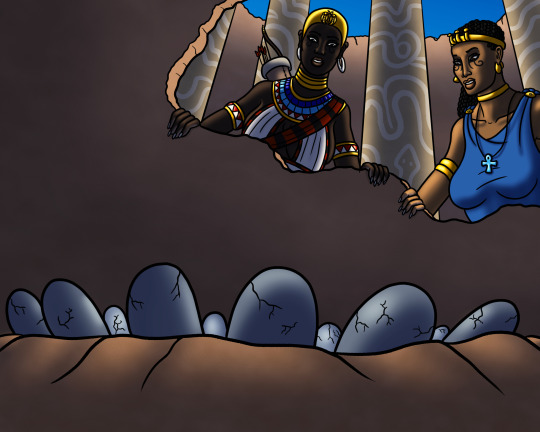
While exploring the ruins of a prehistoric temple out in the Sudanese desert, the queens Amanirenas and Cleopatra (left and right, respectively) discover a clutch of old “dragon eggs” which their ancestors believed represented the brood of Apep, the serpent of chaos in the Egyptian and Kushite religions. However, these two women have more to fear than the wrath of a mythical snake deity…
This is an illustration I did for The Brood of Apep, another short story I wrote starring these two historical queens of the Nile Valley. It’s a sequel to my earlier story Racing Into Trouble, taking place a couple of decades later, when both Cleopatra and Amanirenas have come of age and ascended to the thrones of their respective kingdoms.
#illustration#cleopatra#amanirenas#ptolemaic#ancient egypt#egyptian#kemet#ancient kush#kushite#nubian#african#blackwomen#women of color#dinosaur eggs#fossils#digital art#art
2 notes
·
View notes
Text

ANCIENT GHANA EMPIRE
The Wagadu civilization (Ancient Ghana Empire) was one of the greatest and most influential empires in the history of the world. Thriving between 1600 bce-1240 ce, Wagadu played a major part in the African gold trade to the Nile Valley during pharaonic times. A significant amount of gold in Kush came from Wagadu, which was then shipped up the Nile Valley and dispersed into Eurasia. Gold from Ghana was the source of much gold in the Islamic world during the Moorish Era. Wagadu/Ghana was one of the last great non-Abrahamic empires in Africa.
However, to be clear, the title of the emperor of Wagadu was called the Qore-Nana, or the Qona for short. Qona was also pronounced Gana/Ghana. The word Qore is from the Kushite term for Emperor while the word Nana in pre-Islamic Soninke means "monarch." This Wagadu word "nana" entered neighboring languages, such as their Akan gold suppliers and became a gender neutral status title in Akan for monarchs, family patriarchs/matriarchs, and esteemed ancestors.
The term Qona or Gana (Ghana) refers to the emperor, while the empire was called Wagadu. Arab merchants referred to the empire as Ghana, in reference to the emperor that ruled the region. This term was borrowed by Europeans who translated "ghana" as "Gunia" which became the term Guinea, a western European phrase for all of West Africa, particularly the gold rich regions. In fact, Guinea Gold was the predominate form of gold in Western Europe.
Contrary to Eurocentric misinformation, modern Ghana was a part of the Ancient Ghana Empire, particularly the north region of modern Ghana. Much of the Ghana empire's gold came from modern Ghana, which was then centered around Kintampo.
The central deity of Wagadu was called Bida. Bida is a Soninke version of Damballah Wedo of Vodun, Osumare of Yoruba, and Wadjet in Kemet. This serpentine symbolism of the Supreme Being's essence was exported from Africa to India to become known as Kundalini. It was not the worship of snakes, but the African science of controlling one's reptilian (r-complex) brain that governs instinctual reaction in order to make success an instinct.
When the Abrahamic religion was invented, their mission was always to demonize the study of controlling the reptilian instincts in man's brain, so that the minority elite could be in charge of the masses and turn humanity into mental slaves. They thus turned the quest to control the reptile (Wadjet) into Satan and made the quest to eat of the tree of life's knowledge a sin.
In African spiritual science, the snake is not evil, but a natural part of man's brain. However, it must develop self-control and direction (Wadjet/Bida) or it will strangle the life out of you like a python (Apep). #sarahhistorichomie
2 notes
·
View notes
Text
The Sites of Seth
― Distribution of the Land. Lands of Seth
Geb, the Earth god, arbitrated between the confrontations of the Two Contenders (Horus and Seth) and decided to grant the Upper Egypt to Seth because it was the land where the god was born; and the Lower Egypt to Horus, for it was the land where his father had drowned (Lichteim1975, p.52). Hereinafter, Geb changed his mind and decided to bestow the entire land to the son of Osiris. The Horus myth of Edfu (Egberts 1997) tells that Seth complained and challenged his nephew to be finally defeated. Geb took pity on Seth and his allies, and sent them to the four cardinal points becoming, thus, the patriarchs of the lands surrounding Egypt: Kushites to the south, Asiatics to the north, Libyans to the west and Bedouins to the east (Egberts1997, p.50). This could be an account for the strong association between Seth and the foreign countries.
― Cult of Seth in Upper Egypt
Seth is given the title of “Lord of the Nile Valley Land” in the Pyramid Texts (Allen 2005, PT 155). There were cities and temples devoted to Seth until, apparently, the XXV Dynasty when the cult of Seth became extinct (Redford 2002, p.264), at least in the Nile Valley. Due to the frequent instability during the Intermediate Periods, the areas involved in these cities do not always correspond with the geographical boundaries, arranged by the Ptolemies and called nomes. Hence, I have arranged the cities considering the course of the Nile with disregard of the Ptolemaic organization.
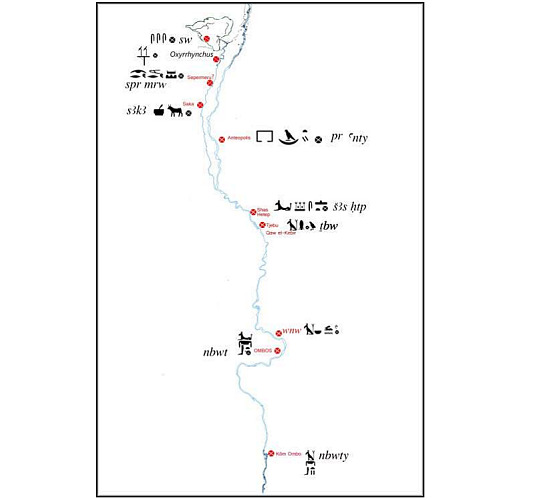
― Seth Lord of Ombos
There are two cities linked with “Seth Lord of Ombos”. One is the modern Kôm Ombo, 42 km south of Assuan, on the eastern bank of the Nile. The other is about 4 km on the northwest of the modern Tukh, in the area of Ballas called Ombos. The name of the former in Egyptian hieroglyphs is nbwty and the latter is nebwt (Daressy 1917, p.80). Ombos/Nebwt, was an important bastion for Seth and his followers during the Predynastic period around 3300 b.C. (Wilkinson 1999, p.37). Petrie (1896) found in this site the remains of an old city and a temple devoted to Seth. There are three steles from this temple exhibited in the Manchester Museum. One of them is the Anhotep Stele, where Seth appears as ‘Lord of Nebwty’ referring Kom Ombo:
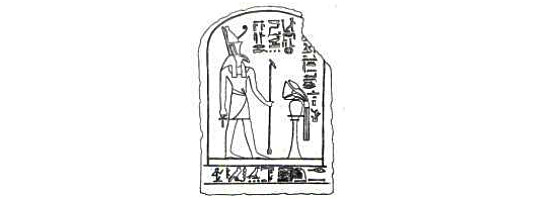
According to Brugsch (1879, p.318) Seth was worshiped in Kom Ombo under the shape of the crocodile Sobek, deem to be the son of Seth (te Velde 1967, p.150). As we will see, crocodiles and hippopotamus were usually considered manifestations of the god Seth. Another piece from Naqada temple of Seth is located at Petrie Museum, London. Seth is featured standing in front of an offering table with an inscription reading: ‘Seth of Nebwt’, alluding Seth of Ombos (web 7). In the main deposit of this temple, Petrie found pieces out of alabaster with inscriptions describing the labor of enlargement made by Tutmosis III, who is mentioned as: “The good god Menkheperra, beloved of Seth of Nebwt”. In a lintel of the Temple, Seth is referred as ‘Seth of Nebwty, Lord of the Southern Land” (Petrie 1896, Pl LXXIX). In a round topped stele, now at the Glyptotek museum, a bull headed winged Seth is called “Bull of Nebwty”. The bull used to be an icon of Seth: in the Leyden Papyrus, “the son of Nwt” (which is a common epithet of Seth) is called “Bull of the night, Bull of Bull”(Griffith 1974, p.80).
― Seth Lord of Wnw and Nashenw
These two cities are sited about 50 km north of Denderah, close to the modern Kasr es-Sayed. Seth is referred as the lord of these two cities, in an inscription engraved in the inner side of the exterior wall at Medinet Habu (Gardiner 1947, p.53).
― Seth Lord of Tjebw
Tjebw (Tbw) was the capital city of the X Ptolemaic nome called wADt. Ancient Greeks called it Anteopolis (the city of the giant Anteus) and was settled on the east bank of the Nile. In latter times, the name of the city changed into Djw-Ka (Dw-qa), ‘the high mountain’ (Barguet 1964, p.8), Qau el-Kebir in Arabic. The original deity of this nome was Antewy, portrayed as a double falcon on a boat and assimilated to Seth, as we can see in the stele of Nakht (XVIII Dynasty):
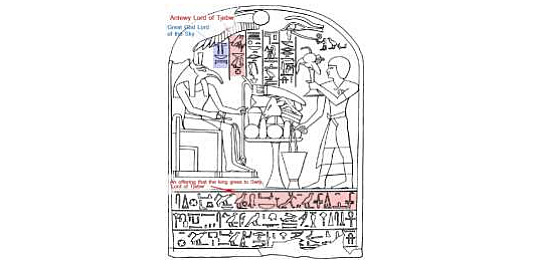
According to Teeter (2003,p.42): “This dual identity is a reflection of the belief that a god could have more than one nature, and that he or she could have the attributes of several deities in order to express the extender power of the god”. This approach is important because all throughout the northern part of Upper Egypt we find the double falcon as the emblem of many cities that could be ancient centers of Seth cult. Over time, the cult of Seth was put aside and replaced by the double falcon, representing the reconciliation between both Horus and Seth (te Velde 1967, p.68). An inscription was found at Qâu showing the priest title sHtp nTrwy, that is to say, ‘Reconciling the two gods’ (Gardiner 1947, p. 53). According to latter versions of the myth, the battle between Horus and Typhon (Seth for the Romans) took place on the river bank close to this city, which was eventually destroyed completely. Today is El-Etmaniyah (Gardiner 1947, p.49). There was a cult to the Sethian animal, the hippopotamus, at Tjebu from the Predynastic period (Lang 1980, p. 361; Gardiner 1947, p.135) shown by a scene of the mayor of Tjebu worshiping a hippopotamus surrounded by papyrus. The inscription here is badly damaged but it could be read as: “Seth, the victorious, the hippopotamus, the Lord of the Tjebw in the nome of wADt” (Brunton 1927, Pl. 32). In the12292 Stele, now at the Oriental Institute in Chicago Illinois, a man called Pa-nehemi stands before Seth as a hippopotamus on pedestal (web 8)
List of Places:
- Seth Lord of Ombos ✔️ - Seth Lord of Wnw and Nashenw ✔️ - Seth Lord of Tjebw ✔️ - Seth of Shashetep - Seth of Per Anty - Seth lord of Saka - Seth Lord of Sepermeru - Seth of Oxyrhynchus - Seth lord of Sw
- Seth lord of Avaris: Seth lord of hwt wart - Seth of Medjem - Seth lord of the Oasis - The temple of Seth at Kharga - Seth in Dakhla Oasis - Seth in Siva Oasis
Others: - Seth Lord of the Foreign Lands - Seth Lord of the Sky
― SETH AND THE ENVIRONMENT ( Maria Jose Amor Martinez )
Related post: The Sites of Seth: Seth and the Environment
#Set#Seth#Setekh#Sutekh#Horus#Heru#Osiris#Wesir#Geb#The Sites of Seth#Maria Jose Amor Martinez#document#Upper Egypt#Lower Egypt#Ombos#Wnw#Nashenw#Tjebw#Nile Valley#Mythology#Cult#Religion#History#temple#devotion#museum#city#Ancient Civilisation#Ancient Egypt#Kemetic
100 notes
·
View notes
Text
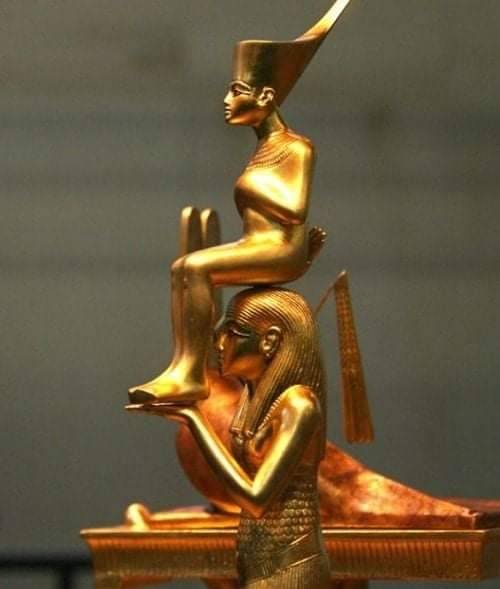
When I tell my people that we need to critique our behavior, we can't stop at the critique, but provide a solution to lift each other up. Both the critique and the solution are provided to us by the ancient Kushite-Kemetics. These answers exist in the deities we are to become.
1. Maat-Iwa. This is harmony. We rejected this deity when we began enslaving each other for Eurasians. While this may have appeared to stop, it just transformed. Now, drug dealers are the new slavetraders. We don't even criticize drug dealers but excuse them as just "trying to hustle a living." That's the same excuse Black slavetraders had when they sold your ancestors. We must create a community where we shame Black people who do negative things (like drug dealing) to the Black community. We must STOP excusing them.
2. Het-Heru/Oshun. We ignore the power of the image, particularly of the Creator in our image. I've gone over this a million times, but it is offensive to the Creator when a race doesn't depict the Creator in their racial image. It offends Him because you don't see him in you, but only see him in other races.
3. Sekhmet/Oya. This is the divinity of intraracial economics. These two warrior deities were the use of economics as the primary tool of war.
Each of the major divinities represent practices that we are to do if we wish to be powerful. Our ignorance of these practices is the critique and our reclamation of these practices is our solution.
We suffer because we want to be liberated but reject our own ancestral culture. We want to be empowered but not unite our money. We want a magic short cut to power. Our lack of unified thinking is why the Creator has denied us His aid. We have not proven that we deserve it. The Creator only helps those who work with each other. If you want the Creator to help you, you must show Him your willingness to help your own race.
67 notes
·
View notes
Photo
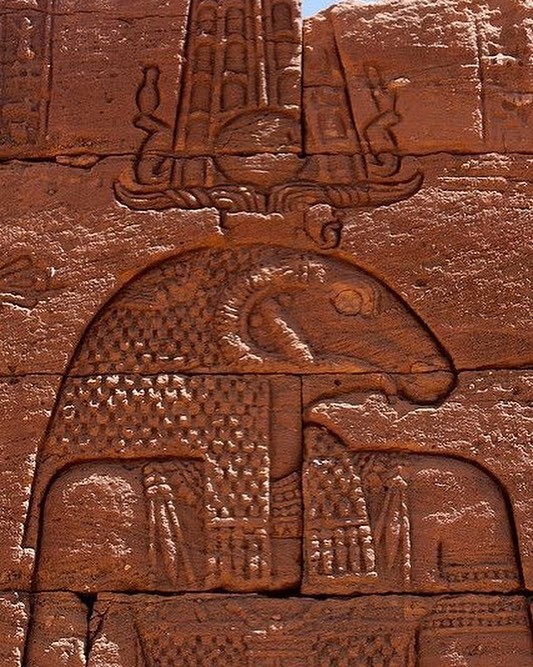
The Lion Temple at Naqa. The well preserved Lion Temple in Sudan located at Naqa. The distinctively brown in colour temple was built by King Natakamani. Known for his passion for arts, Natakamani left a number of buildings and temples. The front of this Lion Temple depicts the king and his wife Amanitore in separate scenes, holding their enemies by the hair while ready to deal a crushing blow. On the sides there are carvings of the royal couple in front of a group of deities, headed by Apedemak and followed by a number of Egyptian ones. One of the unique attributes of this temple is the depiction on the temple's pylon. It pictures Apedemak in rare form, still a human body with a lion head, yet his lower torso is pictured as a snake emerging from a lotus flower. Indeed the bases for Kushite architecture style have been affected by Egyptian civilisation, but since the sunset of the 25th Dynasty and later the move from Napata to Meroe, Kushite iconography has been significantly influenced by indigenous factors. Take the example of Queen Amanitore, where her African features are very clear -- broad shoulders, round head and apparently chunky body. To the contrary of their northern neighbours, the queen in her victory relief appears to be the same size as King Natakamani, a breakaway from the Egyptian style and speculation that the king and queen might have played equal roles. At the rear wall of the temple there is a relief of Apedemak picturing him in the centre while receiving offerings from the king and queen on either side. He appears triple headed and double armed. When you see it, the Indian goddess Shiva would probably be the first thing that comes to mind. Have the Kushites been influenced by far away India? May be, though history states that commercial ties between the two nations through the Red Sea Port of Adulis (near Massawa in Eritrea) have never been concretely confirmed. . . . #Africa #History #traditional #culture #people #Sudan #temple — view on Instagram http://bit.ly/2HcToNH
41 notes
·
View notes
Photo

A powerful king. The small bronze statuette in this group is a magnificent portrait of King Taharqa, born in the Sudan but crowned in Memphis. His power and dual reign over Egypt and Nubia is affirmed by the two uraeus cobras on his forehead. His birth name is engraved on his belt: "The perfect god, Taharqa alive for eternity." Taharqa was the most famous pharaoh of the 25th Dynasty, also known as the reign of the Kushites. He renovated old temples, constructed new shrines, and had official inscriptions written throughout his large empire. A monumental column in the first court of Karnak marks his architectural participation in the great temple of Amun. He is kneeling and clad in the traditional Egyptian kilt. He is much smaller than the majestic falcon, which is covered in gold leaf; the king is offering vases of wines to the animal. A little-known god The inscription on the back of the silver-plated wooden base identifies this bird of prey. This is not the great Horus, but the god Hemen, the patron of the city of Hefat, present-day el-Moalla in Upper Egypt. This deity is rarely mentioned; indeed, this is the only example of a sculpture in the round of this god. Laboratory analyses have revealed that a roughly carved stone falcon was reused and gilded, then placed on a simple wooden base that was plated in silver, along with the sculpture of Taharqa. At first, it appears paradoxical to see a great sovereign alongside an obscure god on the same base, but the inscription on a stele provides the key to this unusual association. A miraculous flood This text, which dates from year 6 of Taharqa's reign, relates how the king, during a famine that followed a drought, prayed to several gods, including Hemen, for extensive flooding of the Nile. The king expressed his gratitude to the gods by dedicating steles and various monuments in their respective temples. This group is therefore an ex-voto placed by the king in the shrine of Hemen, to thank the god for the miraculous flood. With this object. #ancient #egyptian #history #museum https://www.instagram.com/p/CDOfQz5nWYg/?igshid=6n38c28utomt
0 notes
Photo

The divinities of Kushite-Kemetic Spiritual Science were not abstract mysteries nor literal. They signified your divine responsibilities to your community. When you neglect these divine responsibilities, your community becomes a race of slaves. When you live up to your divine responsibilities, your community becomes a race of gods. It's that simple. Support a Black African Deity. Amen-Ra Support Afrocentric nationalist leaders. Ausar Support Afrocentric scholars & authors. Tehuti. Support Afrocentric businesses. Sekhmet Support Afrocentric art, tech, & architecture. Ptah. Improve your neighborhood, don't escape it. Auset. Support Afro-holistic health & dance. Bes Support Afrocentric combat arts. Mentu/Heru Support Afrocentric film, beauty, & music. Muwt/Het-Heru Most of you do none of this but wonder why your people are slaves. This is why. Our liberation has nothing to do with a conversation with Europoids. Our liberation has nothing to do with voting. Nothing to do with marching. Our liberation has all to do with fulfilling the divine responsibilities deified as our African divinities. Kushitekemeticspiritualsciences (Painting by Eyeconic Rtist) https://www.instagram.com/p/B4hdo6LD8FTT1tcr59uIEHmZEoMFUaDjwHPXrk0/?igshid=yj6ciuzh12xi
0 notes
Quote
Temple B 300 the temple of Hathor-Tefnut and Mut, in Gebel Barkel. …The ‘east’ wall reliefs of the Hall of Offerings [B303] depict, however the king praying for entrance into the sanctuary to Hathor-Tefnut and Mut, revealing, thus, that the temple was in fact dedicate to the cult of these two goddesses. A close relationship between Hathor(-Tefnut) and Mut, which allows them to appear as incarnations of the same deity, is clearly indicated in these reliefs: both goddesses are human-headed and wear identical crowns and costumes.
p.78 Török, L., (2002) ‘The Image of the Ordered World in Ancient Nubian Art: The Construction of the Kushite Mind, 800 Bc-300 Ad’ Leiben: Brill
#Hathor#Hathor quotes#Tefnut#Mut#Mwt#kemetic#Torok#Török#The Image of the Ordered World in Ancient Nubian Art#temple#Hathor out of Egypt
9 notes
·
View notes
Photo

Did yu kno that the so - called Negro is the original Egiptian called Nubian Ptahite Ethiopian Kushite , Black or original Hebrew? The word Hebrew in modern Hebrew is IWRIT and in Ancient Hebrew is IBRIY . It is not a race of ppl ; it is not a nationality and it is not a religion. It is not a culture . It is a verb meaning from the other side or to cross over still used in Ashuric / Syraic ( Arabic ) today as Ebra to cross to the other side of the street , which all comes from egipt , Habiru. Yu are referred to as Hebrew , as Abram was later called Ab -Ra - Kemet in Tama - Re Egipt. This Abraham whose name when broken down is Ab =heart , Ra = sun , deity Ham =blackness , crossed over the Hiddekel ( Tigris ) Euphrates ( Gen - 11 : 31 ). The ppl that he chose to live with were known as Phoenicians or Nodites ( Nod ) canaanites from Lebanon . Abraham bowed to Het - father of Hittites. Abraham was really a Chaldean however, the title Hebrew to cross over was attributed to him and thus he was identified by his actions and it became him. Later their dialect became known as the Hebrew language. ; some say Jewish, however the word Jewish is Yiddish word , and not dialect of Hebrew. This must be made clear be cuz many of yu continually refer to yourself as Hebrew Isrealites . That's fine if yu overstand wat Hebrew really means and not pretend for the unknowing population that Hebrew is a religious denomination, culture, race , or nationality when it really isn't . It is simply a title attributed to Abraham when he traveled from Ur of Chaldees and crossed a strip of land called Mesopotamia which was nestled between the Tigris Euphrates rivers as found in Genesis 12 : 6 The so called Negro looks like the Ethiopian or Sudanese than these ppl who call themselves as Hebrews , but Israeli or Jewish. Jewish or Israeli are not in the scriptures. These terms are used be cuz they know that they are not the original Isrealites . That's why they never say that they live in the land Isreal . They use the term , the state of Isreal . The word Jew itself was a nickname for one of the tribes of Judah ( Genesis 29 : 31-35 ) ; and other ppl ( go - ee ) GENTILES , who were https://www.instagram.com/p/BncIxIog_bw/?utm_source=ig_tumblr_share&igshid=11er3ctco5qa7
0 notes
Text
Meroe
Meroë (/ˈmɛroʊeɪ/; also spelled Meroe;[1][2] Meroitic: Medewi or Bedewi; Arabic: مرواه Meruwah and مروى Meruwi; Ancient Greek: Μερόη, Meróē, Biblical; tribe of Merari) is an ancient city on the east bank of the Nile about 6 km north-east of the Kabushiya station near Shendi, Sudan, approximately 200 km north-east of Khartoum. Near the site are a group of villages called Bagrawiyah. This city was the capital of the Kingdom of Kush for several centuries. The Kushitic Kingdom of Meroë gave its name to the Island of Meroë, which was the modern region of Butana, a region bounded by the Nile (from the Atbarah River to Khartoum), the Atbarah and the Blue Nile.
The city of Meroë was on the edge of Butana and there were two other Meroitic cities in Butana, Musawwarat es-Sufra and Naqa.[3][4] The first of these sites was given the name Meroë by the Persian king, Cambyses, in honor of his sister who was called by that name. The city had originally borne the ancient appellation Saba, named after the country's original founder.[5] The eponym Saba, or Seba, named for one of the sons of Cush (see: Genesis 10:7). The presence of numerous Meroitic sites within the western Butana region and on the border of Butana proper is significant to the settlement of the core of the developed region. The orientation of these settlements exhibit the exercise of state power over subsistence production.[6]
The Kingdom of Kush which housed the city of Meroë represents one of a series of early states located within the middle Nile. It is one of the earliest and most impressive states found south of the Sahara. Looking at the specificity of the surrounding early states within the middle Nile, ones understanding of Meroë in combination with the historical developments of other historic states may be enhanced through looking at the development of power relation characteristics within other Nile Valley states.[6]
The site of the city of Meroë is marked by more than two hundred pyramids in three groups, of which many are in ruins. They have distinctive size and proportions of Nubian pyramids.
Contents
1 History
2 Civilization
3 Language
4 Archaeology
5 World Heritage listing
6 See also
7 Bibliography
8 References and notes
9 Further reading
10 External links
1.1 Meroë in Hebrew legend
History
Meroë was the south capital of the Napata/Meroitic Kingdom, that spanned the period c. 800 BCE – c. 350 CE. According to partially deciphered Meroitic texts, the name of the city was Medewi or Bedewi.[7][page needed] Excavations revealed evidence of important, high ranking Kushite burials, from the Napatan Period (c. 800 – c. 280 BCE) in the vicinity of the settlement called the Western cemetery. The culture of Meroë developed from the Twenty-fifth Dynasty of Ancient Egypt, which originated in Kush. The importance of the town gradually increased from the beginning of the Meroitic Period, especially from the reign of Arrakkamani (c. 280 BCE) when the royal burial ground was transferred to Meroë from Napata (Gebel Barkal). In the fifth century BCE, Greek historian Herodotus described it as "a great city...said to be the mother city of the other Ethiopians."[8][9] The city of Meroë was located along the middle Nile which is of much importance due to the annual flooding of the Nile river valley and the connection to many major river systems such as the Niger which aided with the production of pottery and iron characteristic to the Meroitic kingdom that allowed for the rise in power of its people.[6]
Rome's conquest of Egypt led to border skirmishes and incursions by Meroë beyond the Roman borders. In 23 BCE the Roman governor of Egypt, Publius Petronius, to end the Meroitic raids, invaded Nubia in response to a Nubian attack on southern Egypt, pillaging the north of the region and sacking Napata (22 BCE) before returning home. In retaliation, the Nubians crossed the lower border of Egypt and looted many statues (among other things) from the Egyptian towns near the first cataract of the Nile at Aswan. Roman forces later reclaimed many of the statues intact, and others were returned following the peace treaty signed in 22 BCE between Rome and Meroë. One looted head though, from a statue of the emperor Augustus, was buried under the steps of a temple. It is now kept in the British Museum.[10]
The next recorded contact between Rome and Meroë was in the autumn of 61 CE. The Emperor Nero sent a party of Praetorian soldiers under the command of a tribune and two centurions into this country, who reached the city of Meroë where they were given an escort, then proceeded up the White Nile until they encountered the swamps of the Sudd. This marked the limit of Roman penetration into Africa.[11]
The period following Petronius' punitive expedition is marked by abundant trade finds at sites in Meroë. L.P. Kirwan provides a short list of finds from archeological sites in that country.[12] However, the kingdom of Meroë began to fade as a power by the 1st or 2nd century CE, sapped by the war with Roman Egypt and the decline of its traditional industries.[13]
Meroë is mentioned succinctly in the 1st century CE Periplus of the Erythraean Sea:
"2. On the right-hand coast next below Berenice is the country of the Berbers. Along the shore are the Fish-Eaters, living in scattered caves in the narrow valleys. Farther inland are the Berbers, and beyond them the Wild-flesh-Eaters and Calf-Eaters, each tribe governed by its chief; and behind them, farther inland, in the country towards the west, there lies a city called Meroe."
The last period of the city is marked by the victory stele of an unnamed ruler of Aksum (almost certainly Ezana) erected at the site of Meroë; from his description, in Greek, that he was "King of the Aksumites and the Omerites," (i.e. of Aksum and Himyar) it is likely this king ruled sometime around 330.
Meroë in Hebrew legend
Hebrew oral tradition avers that Moses, in his younger years, had led an Egyptian military expedition into Sudan (Kush), as far as the city of Meroë, which was then called Saba. The city was built near the confluence of two great rivers and was encircled by a formidable wall, and governed by a renegade king. To ensure the safety of his men who traversed that desert country, Moses had invented a stratagem whereby the Egyptian army would carry along with them baskets of sedge, each containing an ibis, only to be released when they approached the enemy's country. The purpose of the birds was to kill the deadly serpents that lay all about that country.[14] Having successfully laid siege to the city, the city was eventually subdued by betrayal of the king's daughter, who had agreed to deliver the city unto Moses on condition that he would consummate a marriage with her, under the solemn assurance of an oath.[15]
Civilization
Meroë was the base of a flourishing kingdom whose wealth was centered around a strong iron industry, as well as international trade involving India and China.[16][better source needed][17] Metalworking is believed to have gone on in Meroë, possibly through bloomeries and blast furnaces,[citation needed] and Archibald Sayce reportedly referred to it as "the Birmingham of Africa",[18] because of perceived vast production and trade of iron (a contention that is a matter of debate in modern scholarship).[18]
The centralized control of production within the Meroitic empire and distribution of certain crafts and manufactures may have been politically important with their iron industry and pottery crafts gaining the most significant attention. The Meroitic settlements were oriented in a savannah orientation with the varying of permanent and less permanent agricultural settlements can be attributed to the exploitation of rainlands and savannah-oriented forms of subsistence.[6]
At the time, iron was one of the most important metals worldwide, and Meroitic metalworkers were among the best in the world. Meroë also exported textiles and jewelry. Their textiles were based on cotton and working on this product reached its highest achievement in Nubia around 400 BCE. Furthermore, Nubia was very rich in gold. It is possible that the Egyptian word for gold, nub, was the source of name of Nubia. Trade in "exotic" animals from farther south in Africa was another feature of their economy.
Apart from the iron trade, pottery was a widespread and prominent industry in the Meroe kingdom. The production of fine and elaborated decorated wares was a strong tradition within the middle nile. Such productions carried considerable social significance and are believed to be involved in mortuary rites. The long history of goods imported into the Meroitic empire and their subsequent distribution provides insight into the social and political workings of the Meroitic state. The major determinant of production was attributed to the availability of labor rather than the political power associated with land. Power was associated with control of people rather than control of territory.[6]
The Egyptian import, the water-moving wheel, the sakia, was used to move water, in conjunction with irrigation, to increase crop production.[19]
At its peak, the rulers of Meroë controlled the Nile Valley north to south, over a straight-line distance of more than 1,000 km (620 mi).[20]
The King of Meroë was an autocratic ruler who shared his authority only with the Queen Mother, or Candace. However, the role of the Queen Mother remains obscure. The administration consisted of treasurers, seal bearers, heads of archives and chief scribes, among others.
Although the people of Meroë also had southern deities such as Apedemak, the lion-son of Sekhmet (or Bast, depending upon the region), they also continued worshipping ancient Egyptian gods that they had brought with them. Among these deities were Amun, Tefnut, Horus, Isis, Thoth and Satis, though to a lesser extent.
The collapse of their external trade with other Nile Valley states may be considered as one of the prime causes of the decline of royal power and disintegration of the Meroitic state in the 3rd and 4th centuries CE.[6]
Language
The Meroitic language was spoken in Meroë and the Sudan during the Meroitic period (attested from 300 BCE). It became extinct about 400 CE. The language was written in two forms of the Meroitic alphabet: Meroitic Cursive, which was written with a stylus and was used for general record-keeping; and Meroitic Hieroglyphic, which was carved in stone or used for royal or religious documents. It is not well understood due to the scarcity of bilingual texts. The earliest inscription in Meroitic writing dates from between 180-170 BC. These hieroglyphics were found engraved on the temple of Queen Shanakdakhete. Meroitic Cursive is written horizontally, and reads from right to left like all Semitic orthographies.[21]
By the 3rd century BCE, a new indigenous alphabet, the Meroitic, consisting of twenty-three letters, replaced Egyptian script. The Meroitic script is an alphabetic script originally derived from Egyptian hieroglyphs, used to write the Meroitic language of the Kingdom of Meroë/Kush. It was developed in the Napatan Period (about 700 - 300 BCE), and first appears in the 2nd century BCE. For a time, it was also possibly used to write the Nubian language of the successor Nubian kingdoms.[22]
It is uncertain to which language family the Meroitic language is related. Claude Rilly has proposed that it, like the Nobiin language, belongs to the Eastern Sudanic branch of the Nilo-Saharan family.[23][24][full citation needed] Kirsty Rowan suggests that Meroitic, like the Egyptian language, instead belongs to the Afro-Asiatic family. She bases this on its sound inventory and phonotactics, which are similar to those of the Afro-Asiatic languages and dissimilar from those of the Nilo-Saharan languages.[25][26]
Archaeology
The site of Meroë was brought to the knowledge of Europeans in 1821 by the French mineralogist Frédéric Cailliaud (1787–1869), who published an illustrated in-folio describing the ruins. His work included the first publication of the southernmost known Latin inscription.[27]
As Margoliouth notes in the 1911 Encyclopedia Britannica, small scale excavations occurred in 1834, led by Giuseppe Ferlini,[28] who, as Margoliouth states, "discovered (or professed to discover) various antiquities, chiefly in the form of jewelry, now in the museums of Berlin and Munich."[28] Margoliouth continues,
The ruins were examined in 1844 by C. R. Lepsius, who brought many plans, sketches and copies, besides actual antiquities, to Berlin. Further excavations were carried on by E. W. Budge in the years 1902 and 1905, the results of which are recorded in his work, The Egyptian Sudan: its History and Monuments…[29] Troops were furnished by Sir Reginald Wingate, governor of the Sudan, who made paths to and between the pyramids, and sank shafts, &c. It was found that the pyramids were regularly built over sepulchral chambers, containing the remains of bodies either burned or buried without being mummified. The most interesting objects found were the reliefs on the chapel walls, already described by Lepsius, and containing the names with representations of queens [in Meroitic, Kentakes, Latinised as Candaces[citation needed]] and some kings, with some chapters of the Book of the Dead; some steles with inscriptions in the Meroitic language, and some vessels of metal and earthenware. The best of the reliefs were taken down stone by stone in 1905, and set up partly in the British Museum and partly in the museum at Khartoum. In 1910, in consequence of a report by Professor [Archibald] Sayce, excavations were commenced in the mounds of the town and the necropolis by J[ohn] Garstang on behalf of the university of Liverpool, and the ruins of a palace and several temples were discovered, built by the Meroite kings.[28]
0 notes
Photo

Kushite-Kemetic Spiritual Science
The Nguni people are descendants of Kemetic refugees who sailed to Kenya-Tanzania coast around 320 bce, escaping the wars brought about by the Ptolemaic usurpation of Kemet.
These Kemetic refugees established the proto-Swahili coastal port cities, which they had been trading with since at least the reign of Hatshepsut (15th-century bce).
From the coast of Tanzania, they began the Bantu megaculture. The Bantu are a hybrid of Kemetic refugees mixed with Central-East African Nilotics (like the Luo) and some West African migrates who had arrived thru the Congo rainforest. These coastal Bantu they moved inland and settled in parts of Central-Southern Africa.
As they reached what is now Zimbabwe, they merged with the existing population (which was Nilotic and related to the Luo, Maasai, etc alongside the Xhosa). Altogether, they became known as the Nguni nation (the mother culture of later nations like the Zulu).
The name Nguni is Kemetic, deriving from the divinity Nun (also spelled Nwn). Nun is the ntchr of premordial creative waters, often symbolized by the ocean. Thus, the name Nguni was a reference to the origins of the Nguni from having traveled thousands of miles down the ocean to reach southeast Africa from Kemet.
The Nguni people brought with them their ancient Nile spiritual system. As it was now thousands of miles from their original homeland, their ancient system took on new names. However, they referred to Deity as having come from a marsh full of reeds (the Nile Valley). They began to refer to Amen-Ra (Amenet-Raet) as Ankh-ul-ankh-ulu, a reference to the life giving powers that enabled them to survive their long journey to southeast Africa. Ankh-ul-ankh-ulu eventually came to be pronounced as Unkulunkulu, the Supreme Being.
0 notes
Text
A drawing I made for Lord Apedemak

May he like it
#kushite polytheism#kingdom of kush#kushite#kushite pagan#kushite paganism#kushite religion#the kingdom of kush#kemetic#lord apedemak#Apedemak#apedemak#lion#deity worship#deity#apedemak deity#deity devotion#own work#artists on tumblr#devotional art#devotional acts
16 notes
·
View notes
Text
Images
So um I may have 'made' something. u/Eternalspace1969 made images of many egyptian deities and posted them on Reddit for free use. Considering there were none of Apedemak and Aman I decided to try my hand at editing some of his images to make their representations. So here they are!
Lord Apedemak

Lord Aman

and Lady Amesemi

He has uploaded his own drawings on wikimedia, I really recommend checking them out!
#kushite polytheism#kingdom of kush#kushite paganism#kushite religion#kushite gods#kushite#the kingdom of kush#lord apedemak#apedemak#apedemak deity#aman#lord aman#aman deity#amun#amun-ra#kemetic#pagan#paganism#polytheism#polytheist#drawing
17 notes
·
View notes
Text
Introduction
Hello all and welcome!
My name is Dian, I'm 21 y/o, I am Latino and a pagan.
This is a sideblog for my journey with my deities. I currently worship deities from different pantheons: my own conpantheon, the kushite pantheon (especially the one in worshipped in the meroitic period of Kush), and the etruscan pantheon (aka Rasenna polytheism). Currently like this:
Devoted to:
Danéh & Darukus (Conpantheon)
Worshipping:
Apedemak (Kushite)
Aman (Kushite)
Amesemi (Kushite)
Considering:
Sutekh (Kemetic)
Djehuty (Kemetic-Kushite)
Atari (Kemetic-Kushite)
Sobek (Kemetic)
Inpu (Kemetic-Kushite)
Sekhmet (Kemetic-Kushite)
Dedun (Kushite)
Menerva (Etruscan)
Turan (Etruscan)
Turms (Etruscan)
Uni (Etruscan)
Artumes (Etruscan)
Fufluns (Etruscan)
Atunis (Etruscan)
Iao Sabaoth (Christopagan)
Péh₂usōn (Proto Indo-European)
This might expand and move around in the future of course!
Happy to have you all here :3
#deity worship#deity devotion#pagan#paganism#polytheist#polytheism#conpantheon#personal deity#kushite religion#kushite polytheism#kushite paganism#meroitic#meroe#etruscan polytheist#etrupol#etruscan polytheism#etruscan paganism#etruscan#rasenna polytheist#rasenna paganism#rasenna polytheism#raspol#meroitic gods
16 notes
·
View notes
Text

How does one become initiated into Ntchru (Kushite-Kemetic spiritual science)?
It is very very important that you realize it is SELF-INITIATION. It is about your relationship with the Ntchru and so only you can initiate yourself. Fortunately, Ra Un Nefer Amen wrote this book in 1994 that details how to initiate yourself into Ausar (ntchr, godself). Thanks to him, Afrakans were able to personally access the deities again without financial exploitation by a priesthood.
This doesn't mean you just say you are Ntchru and you are initiated. This initiation involves intense scholarship, daily meditation, and intra-community service. This is detailed in Ra Un Nefer Amen's book. However, what it doesn't involve is a money-hungry priest taking your money at every turn.
This has to be stated because most African traditions have been hijacked by capitalists who tell you that initiation (your introductory link to divinity) requires you doing a ceremony and ritual that you pay them heaps of money to perform. In the corrupted orisa community, these initiation fees average $3,000 to $10,000!!!! It's because of the cluelessness and desperation of the Diasporan to restore their ancestral links, that we fall for this exploitation.
As the Kemetic Renaissance grows, there are people familiar with this corrupt Yoruba practice, that try to bring it into the Kemetic tradition to make money off of your spiritual ignorance and desperation. You don't need to pay a priest to be Kushite-Kemetic!! The initiation is between you and the ntchru, not you and a man. It is about your personal journey to becoming Ausar.
Some others try to make initiation about a pilgrimage to Kemet. Then they have huge tours to "Kemet" and charge you double or triple for everything. The reason this is not valid is because Kemet is destroyed, you can't go to Kemet. You can go to Egypt, a nation controlled by Arabs and Greeks for the last 2,300 years. You can see the ruins of ancient Kemet, but you can't experience actual Kemet there. There are no Kemetic schools in Egypt where you pilgrimage and learn from the indigenous priesthood. There are no people walking around Egypt who communicate in Mdu Ntchr.
Going to Egypt is great, and if you can afford a Black led tour, that's even better, but don't mistake it for a requirement for initiation or status as a Kemetyu in the same way a muslim goes to Mecca. Muslims go to mecca to make you Arabcentric and enrich their Arab masters. Since Egypt is controlled by Arabs, you're basically doing the same thing there. I'm not saying to not go. Go if you can. But not under false notions of it bringing you closer to Kemet. Kemet the place is destroyed. It continues to live thru you, wherever you are in the world.
It is very important that you understand this because our race has dissolved into a race of slave traders over the last many centuries. Our own people prey on each other to see how they can enslave you as a cash cow. They often manipulate your spiritual interests to do so. To stop the modern slave traders, we have to starve them out. We have to starve their access to your money thru exploitation.
This doesn't mean you don't donate to the Kushite-Kemetic movement. You must donate if we are to develop, but it must be of your free will to help; not because of false claims saying it is required rites of initiation or link to the deities.
The deities live in you, thus you are the link to the deities. No ceremony or priest can form this link in you. You are the link when you decide to awaken yourself from within.
5 notes
·
View notes